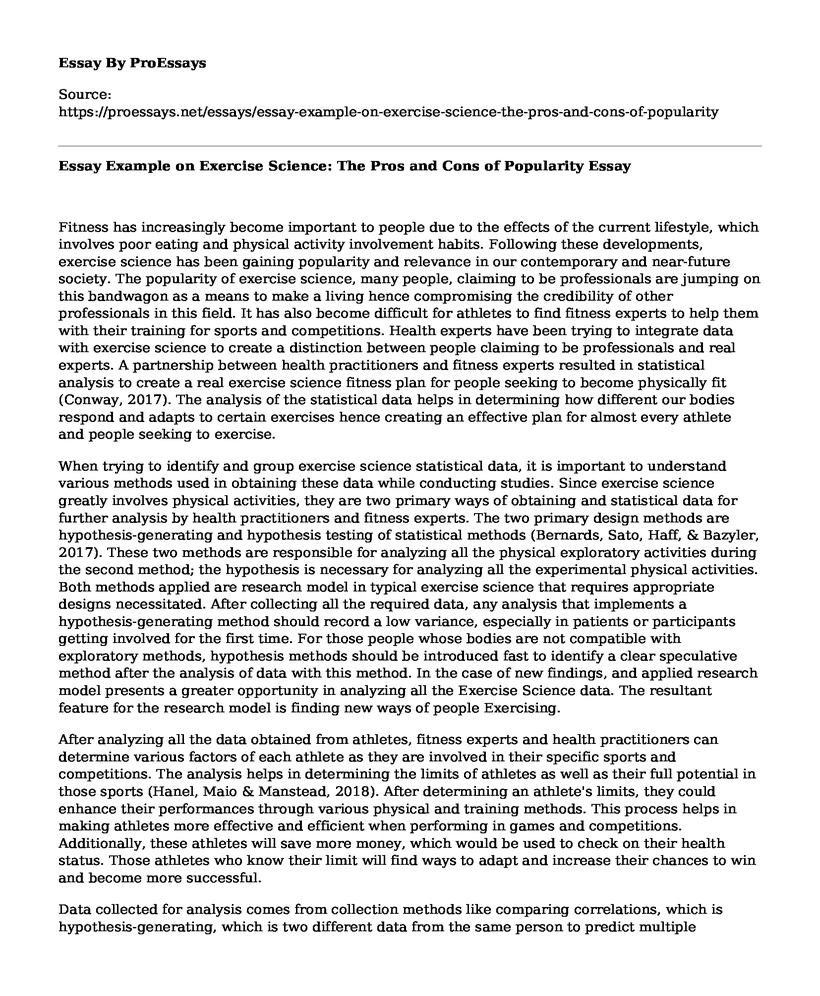Fitness has increasingly become important to people due to the effects of the current lifestyle, which involves poor eating and physical activity involvement habits. Following these developments, exercise science has been gaining popularity and relevance in our contemporary and near-future society. The popularity of exercise science, many people, claiming to be professionals are jumping on this bandwagon as a means to make a living hence compromising the credibility of other professionals in this field. It has also become difficult for athletes to find fitness experts to help them with their training for sports and competitions. Health experts have been trying to integrate data with exercise science to create a distinction between people claiming to be professionals and real experts. A partnership between health practitioners and fitness experts resulted in statistical analysis to create a real exercise science fitness plan for people seeking to become physically fit (Conway, 2017). The analysis of the statistical data helps in determining how different our bodies respond and adapts to certain exercises hence creating an effective plan for almost every athlete and people seeking to exercise.
When trying to identify and group exercise science statistical data, it is important to understand various methods used in obtaining these data while conducting studies. Since exercise science greatly involves physical activities, they are two primary ways of obtaining and statistical data for further analysis by health practitioners and fitness experts. The two primary design methods are hypothesis-generating and hypothesis testing of statistical methods (Bernards, Sato, Haff, & Bazyler, 2017). These two methods are responsible for analyzing all the physical exploratory activities during the second method; the hypothesis is necessary for analyzing all the experimental physical activities. Both methods applied are research model in typical exercise science that requires appropriate designs necessitated. After collecting all the required data, any analysis that implements a hypothesis-generating method should record a low variance, especially in patients or participants getting involved for the first time. For those people whose bodies are not compatible with exploratory methods, hypothesis methods should be introduced fast to identify a clear speculative method after the analysis of data with this method. In the case of new findings, and applied research model presents a greater opportunity in analyzing all the Exercise Science data. The resultant feature for the research model is finding new ways of people Exercising.
After analyzing all the data obtained from athletes, fitness experts and health practitioners can determine various factors of each athlete as they are involved in their specific sports and competitions. The analysis helps in determining the limits of athletes as well as their full potential in those sports (Hanel, Maio & Manstead, 2018). After determining an athlete's limits, they could enhance their performances through various physical and training methods. This process helps in making athletes more effective and efficient when performing in games and competitions. Additionally, these athletes will save more money, which would be used to check on their health status. Those athletes who know their limit will find ways to adapt and increase their chances to win and become more successful.
Data collected for analysis comes from collection methods like comparing correlations, which is hypothesis-generating, which is two different data from the same person to predict multiple variables from a single dependent variable. All these data fit in a Fisher's z-transformation correlation coefficient (Newell, Aitchison & Grant, 2010). Statistical data from Effect Size is important for analysis. It employs Cohen's d effect size, which standardizes two mean groups to form a homogeneity assumption (Spiegelhalter, 2019). The computation of these data involves the use of pooled standard deviation of the groups.
References
Bernards, J. R., Sato, K., Haff, G. G., & Bazyler, C. D. (2017). Current Research and Statistical Practices in Sports Science and a Need for Change. Sports (Basel, Switzerland), 5(4), 87. DOI:10.3390/sports5040087
Conway, B. (2017). Smallest Worthwhile Change. Science for Sport. Retrieved from https://www.scienceforsport.com/smallest-worthwhile-change/
Hanel, P. H., Maio, G. R., & Manstead, A. S. (2018). A new way to look at the data: Similarities between groups of people are large and important. Journal of personality and social psychology. http://dx.doi.org/10.1037/pspi0000154
Newell, J., Aitchison, T and Grant, S. (2010) Statistics for Sports and Exercise Science. Harlow: Pearson Education Ltd.
Spiegelhalter, D. (2019) The Art of Statistics: Learning from Data. Pelican Books
Cite this page
Essay Example on Exercise Science: The Pros and Cons of Popularity. (2023, Mar 28). Retrieved from https://proessays.net/essays/essay-example-on-exercise-science-the-pros-and-cons-of-popularity
If you are the original author of this essay and no longer wish to have it published on the ProEssays website, please click below to request its removal:
- Organizational Behavior Questions and Answers
- English Football and Its Governance: Governance Issues Among Stakeholders Essay
- Adaptive Physical Activity Reflection Essay
- Analyzing a Football Match's Outcome Based on the Teams' Competitiveness - Essay Sample
- Essay Sample on Power Five Conferences: Autonomy from NCAA?
- Research Paper on Hooliganism Fading Away in Modern British Football
- College Athletes: Should They Be Paid? - Essay Sample







